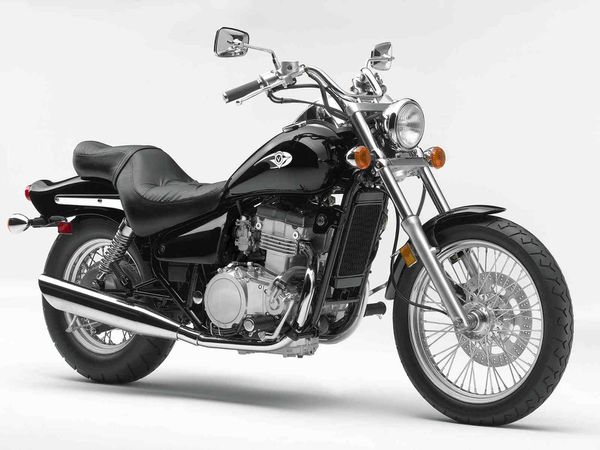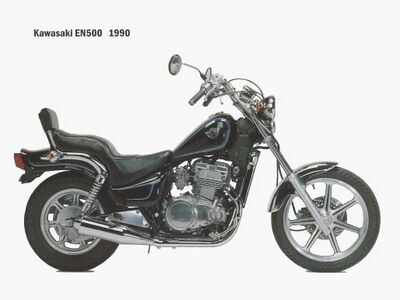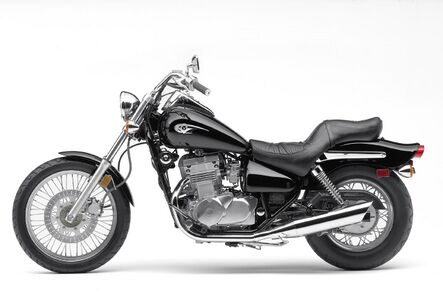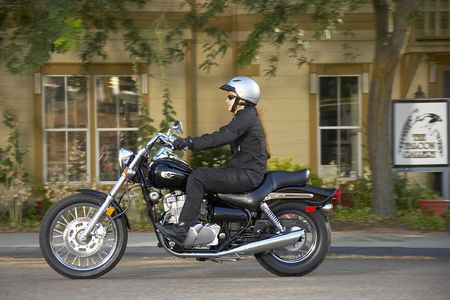Difference between revisions of "Kawasaki EN500 Vulcan"
m |
m (→Photos) |
||
| Line 30: | Line 30: | ||
== Photos == | == Photos == | ||
| − | + | <gallery mode="packed" heights=200px> | |
| − | + | File:Kawasaki-en-500-vulcan-classic-bikes-details-video 8.jpg| | |
| − | + | File:2007-Kawasaki-Vulcan500-LTDd.jpg| | |
| − | + | File:2007-Kawasaki-Vulcan500-LTDa.jpg| | |
| − | + | </gallery> | |
| − | |||
{{Ads_feed}} | {{Ads_feed}} | ||
{{Ads_post}} | {{Ads_post}} | ||
Revision as of 17:54, 27 June 2023
Kawasaki EN500 Vulcan appeared in 1990 and replaced the Kawasaki 454 LTD. Unlike the classic V-engine layout, the Kawasaki EN500 Vulcan gets an in-line 2-cylinder engine from the Kawasaki GPZ 500.
Lineup:
Main competitors:
Subsequently, this engine was installed on a large number of models - in addition to GPZ500, on Kawasaki ER-5, Kawasaki KLE 500 + on domestic Japanese models with a slightly reduced volume - Kawasaki EX-4, Kawasaki KLE 400. Moreover, this engine became the progenitor of the modern engine installed on the Kawasaki Versys 650, Kawasaki ER-6 and Kawasaki Vulcan S models. The first versions of the Kawasaki EN500 Vulcan produced 60 hp. power and 46 Nm of torque. At the time of its release, the Kawasaki EN500 Vulcan was a classic short wheelbase cruiser with a steel frame, cast wheels, classic suspensions (telescopic fork in front, double shock absorber in the rear), rear drum brake and belt drive.
Generations:
- Kawasaki EN500A Vulcan (1990-1996) - first generation. The model is distinguished by the classic appearance of the 80-90s, a forced engine, alloy wheels and a belt drive.
- Kawasaki EN500C Vulcan (1996-2009) - second generation. The model has a more modern appearance, a reconfigured engine (less power, but better traction), spoke wheels and a chain drive. This modification may be referred to as Kawasaki EN500 Vulcan Classic or'Kawasaki Vulcan 500 LTD.
For the domestic Japanese market, a 400 cc version was available - Kawasaki EN 400 Vulcan.
The Kawasaki EN500 Vulcan model was produced until 2009 and was targeted at foreign markets - this motorcycle was not sold in Japan. In 2014, Kawasaki releases the Vulcan S (EN650S) model, which, although it does not position itself as a successor to the Kawasaki Vulcan 500 LTD, can still be called such - an inline 2-cylinder "road" engine wrapped in a modern cruiser.
Photos
Specifications
Specifications Kawasaki EN500 Vulcan:
| Generations | Kawasaki EN500A (1990-1996) | Kawasaki EN500C (1996-2009) |
|---|---|---|
| Motorcycle type | cruiser | |
| Engine type | 2-cylinder, 4-stroke, in-line | |
| Working volume | 498 cc cm. | |
| Cooling | liquid | |
| Bore / stroke | 74x58 mm | |
| Compression ratio | 10.7: 1 | 10.2: 1 |
| Number of valves per cylinder | 4 valves per cylinder (DOHC) | |
| Fuel supply system | carburetor x2 Keihin CVK34 | carburetor x2 Keihin CVK32 |
| Ignition type | transistor | |
| Maximum power | 60 hp at 9800 rpm (54.2 hp at 9500 rpm - on the wheel) | 46 hp at 8000 rpm (34 hp - versions for Germany and Switzerland, 45 hp - France) |
| Maximum torque | 46 Nm @ 8000 rpm | 45 Nm @ 6,000 rpm (39 Nm - German and Swiss versions) |
| Gearbox | 6-step | |
| Drive type | belt | chain |
| Frame | steel tubular | |
| Front suspension | 36mm telescopic fork, 150mm travel | |
| Rear suspension | swingarm with two shock absorbers (adjustable preload), stroke - 100 mm | |
| Front tire size | 100 / 90-19 | |
| Rear tire size | 140 / 90-15 | |
| Front brakes | 1 disc 300 mm, 1-piston caliper | |
| Rear brakes | drum | |
| Dimensions (L x W x H) | 2265x840x1230 mm | 2320x830x1125 mm |
| Saddle height | 730 mm | 715 mm |
| Wheelbase | 1555 mm | 1595 mm |
| Fuel tank capacity | 11.0 l | 15.0 l |
| Maximum speed | 172 km / h | 160 km / h |
| Acceleration to 100 km / h | n / a | 6.7 sec |
| Motorcycle weight (curb) | 199 kg | 214 kg |
Documentation



